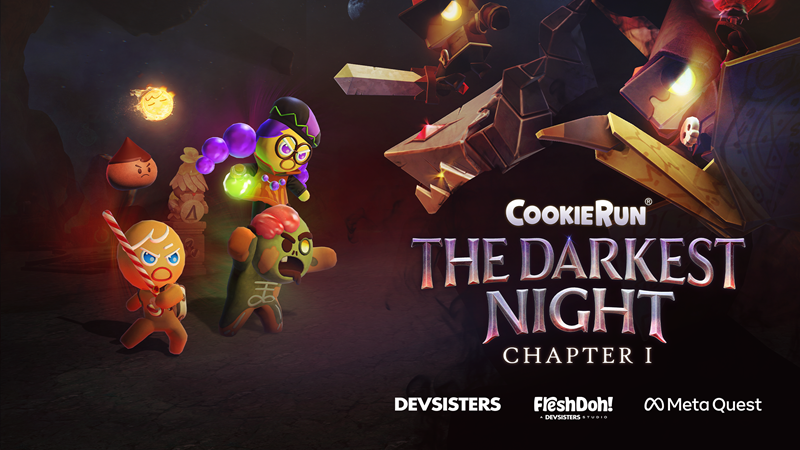
TL;DR for CookieRun: The Darkest Night – Chapter 1
(played and experienced on a Meta Quest 3 128 GB model)
| Pros | Cons |
| + Stunning visuals | – Too easy |
| + Novel and immersive mechanics | – Unskippable, boring dialogue |
| – Vacant sound design | |
| – Lots of bugs |
Among the VR games released this winter, CookieRun: The Darkest Night – Chapter 1 (which we’ll just call CookieRun for brevity, despite other games from this publisher sharing the name) stood out as a promising candidate. Its beautiful trailer full of vibrant characters gives a real sense of story, adventure, charm, and—oh (hell) yes—whimsy.
I see the trailer for this here cookie game and I’m reminded of colorful gems like Ōkami or Ni No Kuni or about two-thirds of the Zelda franchise; Ghibli-esque fantasy romps whose vibrant, stylized aesthetics set the stage for spectacular adventure and deep, interesting gameplay!
Unfortunately, this is not one of those games; not by a long shot.
STORY
CookieRun has you playing as Ginger Brave, the Chosen One, the only cookie without the word “cookie” in your name. The Prophecy says that you will be the one to finally lead your people out of the dangerous castle from which you were baked.
“Wake up, Link!” plus or minus some words, says the little glowing fae who starts your journey. In this little bit of familiarity and others, CookieRun shows how much it wants to be a VR Zelda game. I want that also. And The Legend of Cookie does succeed at that in at least one respect: its total disregard for sensible world-building.
While I wasn’t exactly expecting realism from the cookie game, I still found it lacked the usual focus on internal logic found in the fantasy genre.
Why is the Darkest Lord Cookie called that when he’s clearly made of Devil’s Food Cake? Why is falling sometimes a lethal threat and sometimes a cutscene and a slide whistle? Why do cookies heal by eating meat and why does that meat come from a bonsai tree?(!)
The unsatisfying but honestly understandable implicit answer is “If you can suspend disbelief enough to play as a VR Cookie Messiah then you have it within you to absolutely not worry about it.”
Okay, fair. And while, no, I wasn’t exactly expecting realism from the cookie game, I still found it lacked the usual focus on internal logic found in the fantasy genre—especially something so dialogue-heavy—even if it is but a short, cutesy incarnation of that genre.
And to be fair, it might be that there are a lot of loose threads only because this game is Act One of a three-act series. The argument could be made that the priority for Act One ought to be, in fact, to flesh out characters and relationships before diving more deeply into the world. So if that’s what ends up happening in Acts Two and Three then feel free to tell me and I’ll retract this particular critique. And if someone doesn’t tell me, then I won’t find out.
Alright, why am I putting so much emphasis on the story here? Well because the game puts so much emphasis on the story. In many ways, CookieRun feels less like a game and more like a storybook that you have to interact with to move through. The gameplay in Cookie Storybookie is actually easy to the point of being hard to fail.
GAMEPLAY
For combat: Your candy-cane swords have huge hitboxes and also act as shields. Enemies—including bosses—fall quickly since your attack speed is only limited by your own capacity to feverishly wiggle your hands about. You have invincible pets who help you in battle. You take a ton of hits before falling. And healing meats are abundant. Should you somehow die, you will respawn to wherever you were most recently safe with no consequences.
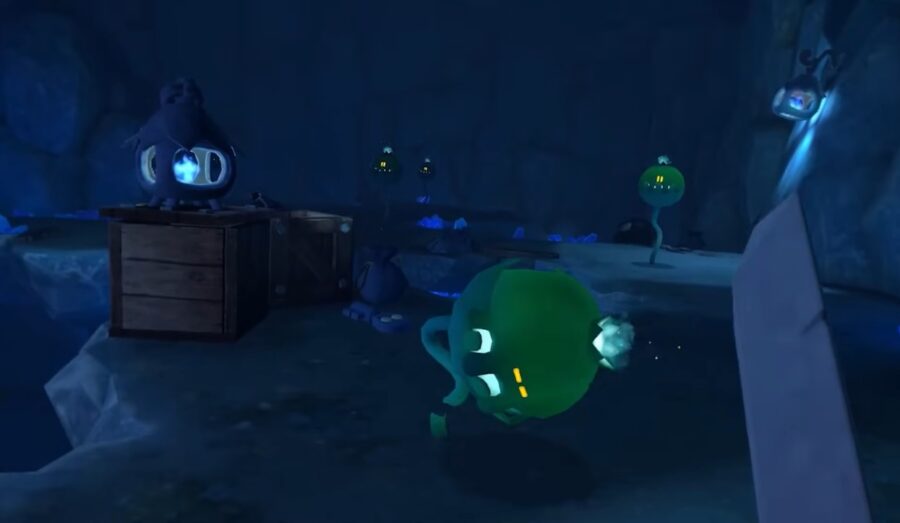
Puzzles too, are a total non-challenge. The most common type of puzzle is one where you have to rotate a symbol until it matches the symbol above it. And if that weren’t easy enough, you’re able to literally not even look at the corresponding symbol and just attempt to rotate the one below it 360°. The game will stop you from rotating further than the right answer and you’ll be rewarded with a Brave Soul, a currency used to upgrade Ginger Brave’s health and stamina a la Spirit Orbs from Breath of the Wild.
These novel gimmicks unfortunately do little to counter the game’s core lack of challenge.
In terms of cool VR-specific mechanics, the game takes lessons from—funny enough—thrillers like Resident Evil 4 and Half-Life: Alyx. Interactions that might normally be done on an overlaid menu—like pulling up a map, drawing your weapon, or stashing items—are instead done diegetically, by bringing the controller to a relative spot on your body where those things are stored. And to check your health or summon your pet, you interact with a wristwatch-like magic bracelet.
These novel gimmicks unfortunately do little to counter the game’s core lack of challenge (and therefore lack of potential for flow). Gameplay is a verdant, winding, singular pathway—decorated with levers and bobbles—that takes you to the next bit of dialogue.
And there is a lot of dialogue… unskippable dialogue.
Not only is the dialogue unskippable, but, hey, it’s also poorly written! And more often than not, you aren’t allowed to leave a given NPCs’ radius while they’re talking. Already figured out what to do next in the game? Just want to try stuff out? Too bad! Wizard Cookie has decided he’s feeling chatty just now. So you get to wait around in plodding conversation until NPC exposition-bot finishes printing out that paper with the word “go” on it.
And in the instances where you aren’t physically tethered to your NPCs, the game will find other creative ways to stop you from progressing until it’s all finished its chittering.
Like I thought that if I shot at those plump bits of meat hanging from the bonsai tree with my slingshot they’d fall down. But oh well, I guess not… Wait, what’s that, gnome NPC? I should shoot the hanging meats with my slingshot? Well, great idea! And now—because you’ve just told me to do it—it works!
Hey, there’s three puzzle pieces missing from this jigsaw puzzle on the witch’s desk! Maybe I should find them and put them back into place. Aw gee, nothing happened… Wait, what’s that Alchemist Cookie? No, I already saw the puzzle and put the pieces back and- Oh… Now that you’ve finished telling me that I should solve the puzzle, the solved puzzle has turned into a MacGuffin-delivering portal! Great!
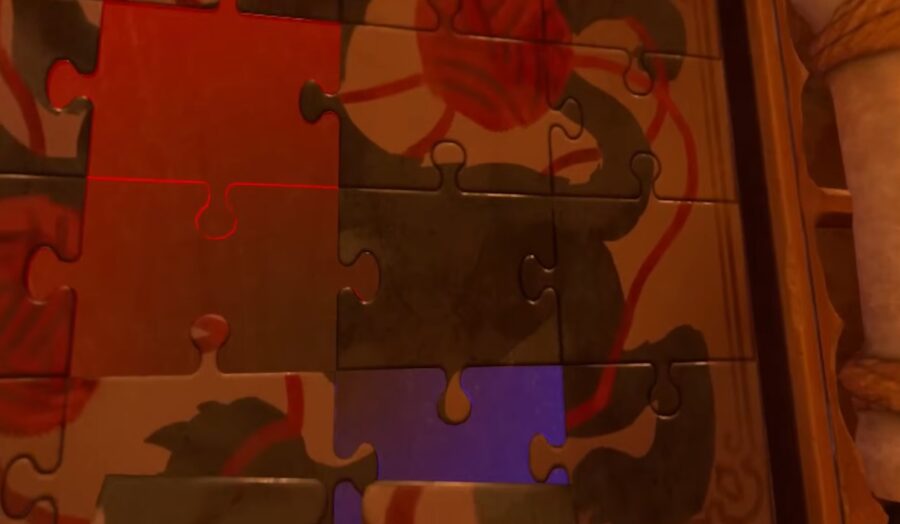
Now when I say the abundant and unskippable dialogue is poorly written, I basically just mean that it’s for kids. And based on the level of language used, it’s probably for kids too young to be using VR. It’s poorly written in the way that Dora the Explorer could be called poorly written. It’s repetitive and overly expository to make sure that six-year-olds can grasp what’s going on.
It might seem strange how I’m basically complaining that a piece of media where you play as the Gingerbread Man’s chibi counterpart turns out to be for babies, as if the aesthetic didn’t give it away. But this isn’t a movie. This is a video game (sort of).
And gaming has a long history of defying its own bubbly aesthetics with challenging gameplay. To see what I mean, just go the shortest possible distance from the very concept of a video game to the nearest concrete example of one: Mario games have long made it plain that bright smiling clouds and happy dancing flowers are entirely compatible with a challenge.
The team at Studio FreshDoh! really did an excellent job of making the most out of the Meta Quest 3’s hardware capabilities.
So I refute the idea that a game’s visuals are ever enough to judge how difficult it will be. But while we’re on visuals—it must be said—CookieRun is absolutely gorgeous.
Every character is well communicated through their design, and their magical world is just bubbling with life. Visual attention to detail is all over the backgrounds and set pieces. Candle flames and glowing spirits illuminate the atmosphere of tabletops and bookshelves that your little gingerbread feet tap along.
The team at Studio FreshDoh! really did an excellent job of making the most out of the Meta Quest 3’s hardware capabilities. I often found myself staring out over the landscape from up high, just taking in the beauty of this cozy fairytale come to life.
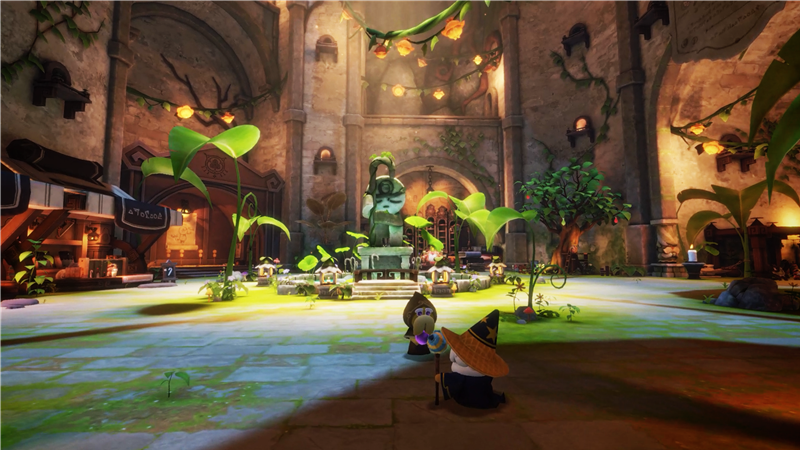
Oh dear reader, how I wish that I could wrap this up on that high note with no further gripes. But for all of the love the developers gave to the visuals, there is a total lack of care in the sound design. Lots of crucial moments where there ought to be a major sound effect simply had none, ruining immersion and making things feel weightless and unfinished.
At other points, sound design didn’t accurately reflect the space I was in. Loud, obviously close footsteps would turn out to be the product of an enemy far off in the distance. The voice acting, too, is all over the place. Some characters pull you in with charm or gravitas, whereas others—who, again, you are actively forced to listen to—are just plain annoying.
And the bugs! Bugs are everywhere both mild and severe: a malfunctioning start menu, near-constant and unprompted haptic feedback that forced me to turn the feature off, the recurring inability to open my item bag, and a faulty save state that dropped me off the map every time I loaded my game.
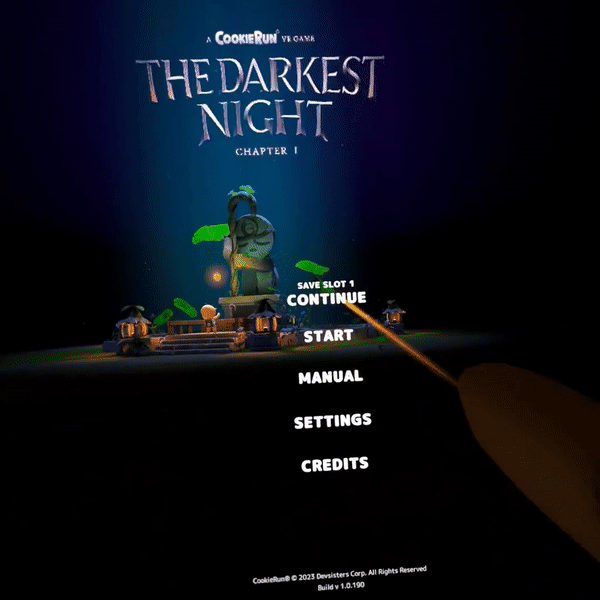
Since release, the dev team has put out a patch dealing with some of the bugs as well as sound issues, so there’s hope at least that this first entry into the series might get enough TLC to turn things around down the road.
There is a lot of potential here. And if the love from the devs continues—maybe a harder difficulty mode gets added, as well as the option to skip dialogue—then CookieRun could be a real winner.
But even then, at USD $25 for about three to eight hours of gameplay (maybe even two hours if you subtract the yapping) I can only recommend it if you’ve got extra cash, a deep love for whimsical aesthetics, and zero desire for a challenge.
VERDICT
CookieRun is an unfinished game with a lot of good ideas and tremendous visual polish. You can hardly expect a more beautiful game given the hardware. But the beauty and creative mechanics are undone by bugs, slow pacing, poor audio, and an understimulating level of ease.
I wanted this game to be excellent, and with enough attention from the dev team it might even get there. For now though, there’s just too much standing in the way of what feels like should be a good game.
If you’re interested in a guided tour through a small but beautiful world of wonder, or if you want to smash through a Candy Land power fantasy, then this game might be right for you!
Otherwise, CookieRun: The Darkest Night – Chapter 1 gets a 4/10.
Scoring & Rubric
Scores are out of 10, where 10 is a masterpiece, 1 is the opposite, and 5 is just average. Gameplay has a heavier weighting in the overall score.
Gameplay – 2
Immersion – 7
Visuals – 10
Sound – 4
Performance – 3
Replayability – 5
Image / video credit: Studio FreshDoh! / YouTube. Screenshots & GIFs: Auganix
About the author
Kierkegaard once said that the artist is like one stuck inside Phalaris' brass bull, which burned up its victims and—due to the formation of its apertures—made beautiful music from their anguish.
The critic, he said, is just like the artist except he doesn't have the anguish in his heart nor the music on his lips.
A lifelong gamer based out of Vancouver, Pelé disagrees with Kierkegaard.
